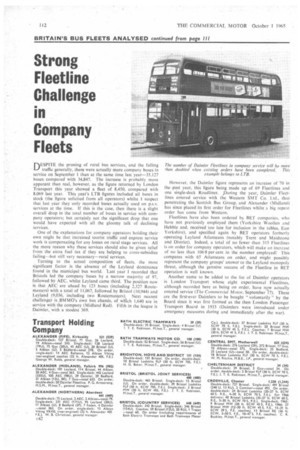Strong Fleetline Challenge in Company Fleets
Page 114

If you've noticed an error in this article please click here to report it so we can fix it.
DESP1TE the pruning of rural bus services, and the falling traffic generally, there were actually more company buses in service on September 1 than at the same time last year-35.127 buses compared with 34,847. The increase is probably more apparent than real, however, as the figure returned by London Transport this year showed a fleet of 8,450, compared with 8,069 last year. This year's LTB figures included all buses in stock (the figure solicited from all operators) whilst I suspect that last year they only recorded buses actually used on p.s.v. services at the time. If this is the case, then there is a slight overall drop in the total number of buses in service with company operators; but certainly not the significant drop that one would have expected with all the gloomy talk of declining Services.
One of the explanations for company operators holding their own might be that increased tourist traffic and express service work is compensating for any losses on rural stage services. All the more reason why these services should also be given relief from the extra fuel tax if they are helping to cross-subsidize failing—but still very necessary—rural services.
Turning to the actual composition of fleets, the most significant factor is the absence of the Leyland dominance found in the municipal bus world. 'Last year I recorded that pristols led the company buses by a narrow majority of 97, followed by AEC, whilst Leyland came third. The position now is that AEC are ahead by 123 buses (including 2.327 Routemasters) with a total of 11,067, followed by Bristol (10,944) and Leyland (9,036, including two Routemasters). Next nearest Challenger is BMMO's own bus chassis, of which 1,640 are in service with the company (Midland Red). Fifth in the league is Daimler, with a modest 369.
However, the Daimler figure represents an increase of 70 in the past year, this figure being made up of 69 Fleetlines and
one single-deck Roadliner. uring the year, Daimler Fleetlines entered service with the Western SNIT Co. Ltd., thus penetrating the Scottish Bus Group, and Alexander (Midland) has since placed its first order for Fleetlines whilst a big repeat order has come from Western,
Fleetlines have also been ordered by BET companies, who have not previously employed them (Yorkshire Woollen and Hebble and, received too late for inclusion in the tables, East Yorkshire), and specified again by BET operators fortnerly operating Leyland Atlanteans (notably Trent and Maidstone and District). Indeed, a total of no fewer than 315 Fleetlines is on order for company operators, which will make an increase of no less than 106-8 per cent in the number employed! This compares with 65 Atlanteans on order, and might possibly represent the company groups' answer to the Leyland monopoly threat, although the genuine success of the Fleetline in BET operation is well known.
Another name to be added to the list of Daimler operators is London Transport whose eight experimental Fleetlines, although recorded here as being on order, have now actually entered service (The Commercial Motor, September 17). These are the first-ever Daimlers to be bought " voluntarily " by the Board since it was first formed as the then London Passenger Transport Board in 1933 (Daimlers were introduced under emergency measures during and immediately after the war).












































































































































































